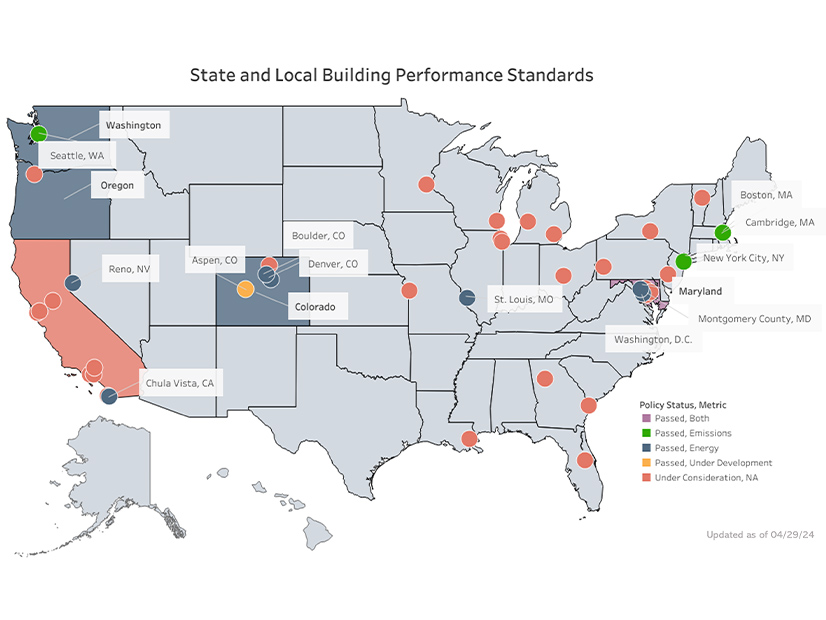
The U.S. Department of Energy aims to help cities and states reduce emissions and improve the efficiency and resilience of existing commercial and multifamily buildings with more than $240 million in grants to promote the adoption of building performance standards (BPSs).
Funded by the Inflation Reduction Act, the 19 awards announced Aug. 27 include grants for statewide programs in Colorado, Hawaii and Washington, as well as local programs in Chula Vista, Calif., Evanston, Ill. and Montgomery County, Md.
For example, Cincinnati, Cleveland, Columbus and Dayton, Ohio, are joining forces on a $10 million grant to develop a BPS and create a High Performance Buildings Hub, which will be a one-stop shop for “connecting building owners to financing solutions and incentives along with the support, education and training needed to meet BPS targets.”
Colorado is up for three separate awards:
-
- $20 million for a statewide program to provide technical assistance for upgrading buildings in low-income, disadvantaged communities.
- $7.5 million for Denver to implement its existing BPS and start working on future, more rigorous standards.
- $5 million for Lakewood, a Denver suburb, to develop and implement a local standard in line with the state BPS and launch “a significant workforce development effort to support covered buildings.”
These and other similar awards underline the need for building performance standards for existing buildings, as a supplement to building energy codes that cover new construction. The grants also are intended to help boost the local capacity and workforce development needed for successful adoption and implementation.
“State and local governments are taking on advanced, proven solutions that will help [cut] energy bills while making their communities more resilient in the face of climate change,” Energy Secretary Jennifer Granholm said in the funding announcement. The IRA dollars will help “jurisdictions move further and faster in implementing stronger codes that will provide Americans safer, healthier and more comfortable places to live, work and play.”
Building Codes vs. BPS
With buildings across the United States — including 60 billion square feet of commercial floor space — accounting for about 35% of the country’s greenhouse gas emissions, the Biden administration earlier this year set ambitious targets for reducing emissions from buildings 65% from 2005 levels by 2035 and 90% by 2050.
Getting there undoubtedly will be complicated. Building codes cover new construction and major renovations, and in general are updated every three years by industry standards-setting bodies. The International Energy Conservation Code covers residential buildings, and the American Society of Heating, Refrigerating and Air-conditioning Engineers (ASHRAE) provides standards for commercial buildings.
But states determine whether to adopt the most recent codes. ASHRAE’s latest update in 2022 was 14.4% more efficient than the code released in 2019, according to DOE. An ASHRAE fact sheet notes that only Alabama, Indiana, New Jersey, Oregon, West Virginia, New York and Washington, D.C., directly adopted the 2022 update.
Building performance standards have become another flashpoint for state and local policy makers. Only one state, Maryland, has enacted a BPS that sets standards for both energy efficiency and emissions reductions for commercial buildings of more than 35,000 square feet. The law is scheduled to go into effect in 2025.
The rest of the country is a patchwork. Washington state, Oregon and Colorado each have set a BPS for energy use but not emissions. Seattle, New York City and Cambridge, Mass., have passed standards for emissions but not energy.
The Biden administration launched the National Building Performance Standards Coalition in 2022, with 33 state and local members and an ambitious goal for all participants to have equitable BPS programs and policies in place by Earth Day 2024.
At the end of 2022, coalition members accounted for 25% of all commercial buildings in the U.S. and, if they had met their BPS commitments, would have cut emissions equivalent to the GHG pumped out by 5.4 million U.S. homes. The coalition now has 46 members.
The IRA provides $1 billion to help cities and states adopt model and updated energy codes. The Aug. 27 announcement is the first round of awards for this program. Applications are open for a second round of awards, with a deadline of Sept. 13.


